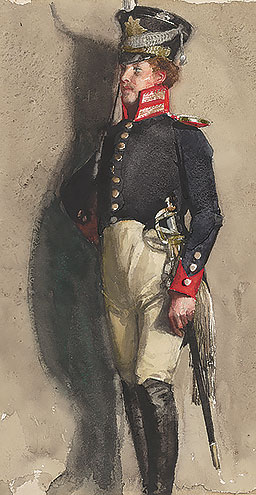No less confident than the young woman from Berlin does the Guard Lieutenant, whom Skarbina likewise represented in multiple views, present himself (Fig. 1). With this image the artist embraced a theme that preoccupied him throughout his life. He himself described in 1902 some of the lasting impressions from his childhood: “I rhapsodized over soldiers back then, in the evenings — the military tattoo — it was bliss. It is amazing how all things military attracted me. I hardly understood how to hold the pen correctly even when I began to draw. And I still have not outgrown that joy even today.” The Portrait of the Guard Lieutenant in three-quarter Profile (Fig. 1) anticipates this fascination in a special way. Once more was the artist far less interested in representing the uniform in all its decorative finesse than with depicting the soldier’s overall effect. Only the strategically-placed reflections and lines articulate Skarbina’s constant interest in the rendering of luministic and coloristic effects that comes to its fullest expression through the distinctive play of light and shadows in his watercolours. This tendency probably goes back to the artist’s earliest experiences in his father’s goldsmith workshop, where reflections from the lamplight, in conjunction with water droplets — so-called “shoemaker’s globes” —, made a lasting impression upon him. In his painterly handling of military subjects, Franz Skarbina went even beyond the scope of his great idol, Adolph von Menzel (1815-1905). Already as a fifteen-year-old Skarbina had become acquainted with Menzel’s Armeewerk (1843-1857) in the Prints and Drawings collection of the National Gallery in Berlin and had eagerly copied the uniforms depicted in the image. Thereafter, in 1906, Skarbina himself supported the reprint of this publication of his predecessor as co-editor of the new edition.

